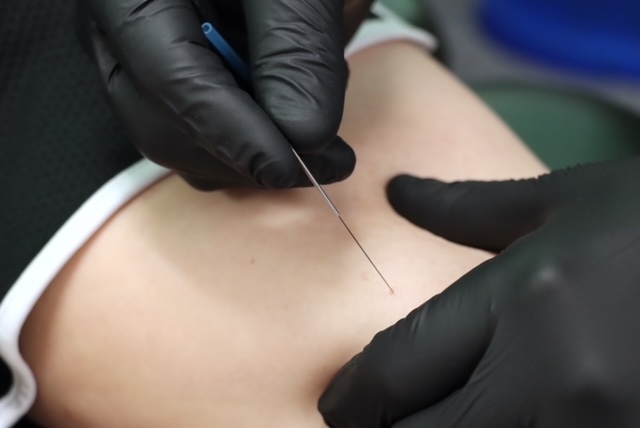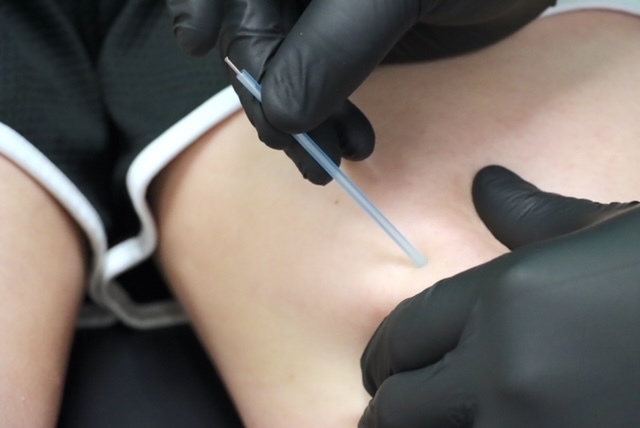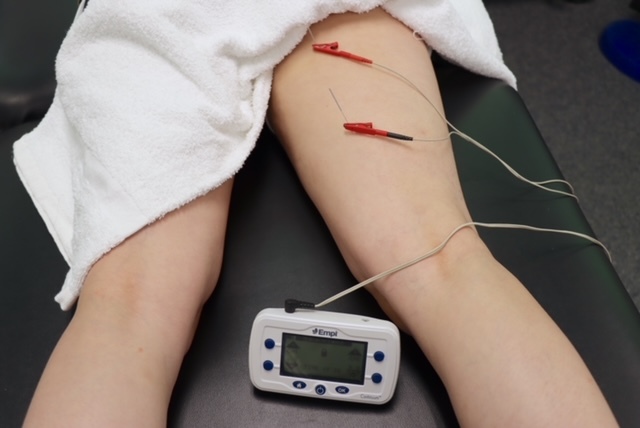Introduction
The treatment technique called dry needling is defined by the American Physical Therapy Association(APTA) as a skilled intervention that uses a thin filiform needle to penetrate the skin and stimulate underlying myofascial trigger points, muscular, and connective tissues for the management of neuromusculoskeletal pain and movement impairments (Figure 1).1 A trigger point(TrP) is a hyperirritable spot in a taut band of skeletal muscle that is painful on compression, stretch, overload or contraction of the tissue which usually responds with referred pain that is perceived distant from the spot.2,3 Trigger points can be active, passive or latent. Active TrPs cause a reproduction of the patient’s familiar pain with or without palpation. Passive trigger points do not cause pain except when stimulated via palpation. With latent TrPs, the local and referred pain do not reproduce any symptoms familiar or usual to the patient when palpated.2,3
Figure 1. A thin filiform needle to penetrate the skin and stimulate underlying myofascial trigger points, muscular, and connective tissues for the management of neuromusculoskeletal pain and movement impairments.

History
In 1938 Sir Thomas Lewis, and his fellow John Kellgren demonstrated that the injection of a saline solution into muscles led to pain being referred somewhere else.4–6 Kellgren would go on to chart zones of referred pain in neighboring and distant tissue.7 In 1942, Dr. Janet Travell–a former cardiologist- ended up publishing her first paper with several colleagues, “Pain and Disability of the Shoulder and Arm: Treatment by Intramuscular Infiltration with Procaine Hydrochloride.8 She was treating herself from shoulder and arm pain by performing injections into the muscles.8 In 1952, she would go on to identify the pain patterns of trigger points in 32 skeletal muscles.8,9 Dr. Travell would go on to meet Dr. David Simons who was interested in the science behind referred pain. They ended up publishing Myofascial Pain and Dysfunction: The Trigger Point Manual in 1983. It was divided into two volumes. Volume I covered the upper extremities and Volume II covered the lower extremities. This was a guide that was useful for the diagnosis and location of trigger points.6
Dry needling, or using a needle without an injected anesthetic, would come into play when Karel Lewitt’s article, “The Needle Effect In The Relief Of Myofascial Pain” came out in 1979. He demonstrated analgesic effects of painful spots which came from the needle alone. The immediate analgesia has been called the, “needle effect.”10
Peter Baldry would go on in 2002 to distinguish between superficial vs deep dry needling. He found that 90 percent of his patients suffered from uncomplicated nociceptive pain from TPs.7 They could be treated with superficial dry needling which is safer and less painful to the patient when compared to deep dry needling. Deep dry needling should be reserved for those with more complicated nerve root pain with concomitant myofascial TP pain.
Popularity and significant interest in dry needling didn’t grow until after the year 2000. In 2010, jurisdictions sought information from the Federation of State Boards of Physical Therapy (FSBPT) regarding the criterion for physical therapists to be able to practice dry needling.11 In 2015, the FSBPT, APTA, and seven dry needling experts composed a task force that set forth a final set of competencies for physical therapists for the safe and effective use of dry needling in clinical practice.11
Technique
Adept palpation skills are used to identify a trigger point. A flat or pincer grip is utilized to identify the problematic area with the palpating hand. The needling hand places the needle and guide tube at the site (Figure 2). The needle is tapped into the epidural layer of the skin and the guide tube is discarded. The dominant hand is used to insert the needle perpendicular to the muscle superficially to the subcutaneous tissue, or deep into the muscle to penetrate the trigger point. This is known as superficial (SDN) , or deep dry needling (DDN/TrP-DN) respectively.3 The needle can be left in situ for a short period of time (up to 20 minutes) or pistoned in and out of the muscle, causing a twitch response from the trigger point. During a pistoning technique, once the acetylcholine is depleted at the end plate, the twitching will stop and the needle is removed and discarded appropriately in a sharps container.
Figure 2. The thin filiform needle in the guide tube at the site in preparation to be tapped into the epidural layer of the skin.

Physiologic Effects
With regards to Myofascial Pain Syndrome (MPS), Simons proposed the ‘Integrated Trigger Point’ hypothesis model.12 It is thought that at the motor end plate excessive acetylcholine is released. Acetylcholinesterase is inhibited at the end plate which leads to increased motor plate activity.3 The increased motor plate activity leads to a continual release of calcium ions(Ca +2).13 This may explain why a trigger point is present.
It’s also a possibility that trigger points may also develop from repetitive low load or moderate overuse.14 This is referred to as the “Cinderella hypothesis.”14,15 Henneman’s size principle states that smaller type I fibers are recruited first and de-recruited last. These “Cinderella” fibers are recruited continuously due to the fact that the large motor fibers don’t have to work as hard.14,16 Due to the sustained muscular contractions, hypoxia may develop.14 This leads to a drop in pH. Low pH can trigger the release of inflammatory mediators and neurotransmitters such as: calcitonin gene-related peptide (CGRP), prostaglandins(PG), substance P, 5-HT, and ATP among others.3 This can cause increased nociceptive input to the spinal cord which can lead to peripheral and central sensitization.3
Sometimes the introduction of the needle into the trigger point with deep dry needling elicits a local twitch response (LTR). It’s not well understood why this occurs. After the LTR it has been observed that there is a decrease in concentrations of CGRP, substance P, interlukins, and cytokines.3
Dry needling can also be used in cases of long-standing tendinopathy. The cause of tendinopathy is not completely understood. There are three main theories in which we think they may arise. The mechanical overload theory would suggest that the tendons are repetitively overloaded in a higher end of their physiologic range causing a maladaptive response to the repetitive microtrauma. The vascular theory suggests that tendinopathies arise because tendons generally have poor blood supply making them more susceptible to vascular compromise.17 Finally, the myofascial theory associates the maladaptive tendon process to taut, shortened, muscles providing an adverse traction force to the tendon attachment site or creating unnecessary friction in the tendon sheath.18
Treating tendinopathy with dry needling has been used for decades.19 Dry needling of a tendinopathy in theory induces a microtrauma to the tendon causing a subsequent migration of inflammatory cells into the degenerative tissue as well as influx of satellite cells to promote collagen repair from the weaker type III collagen back to stronger type I collagen. This ultimately disrupts the chronic degenerative process and allows for healing of the affected tissue.19
Indications and Contraindications
Dry needling may be indicated for myofascial pain with the presence of trigger points.1 Trigger points may lead to impairments in body structure, pain, and functional limitations.1 (Dry needling has been shown to be beneficial in addressing strains,20 osteoarthritis,21–23 and tendinopathies.24–26
Dry needling is not recommended for children under the age of 12.1 There are several absolute and relative contra-indications to dry needling which include but are not limited to:
patients with needle phobia or unwillingness to try DN.1
significant cognitive impairment and lack of understanding for DN parameters.1
local or systemic infections.1
localized edema1
Vascular disease (i.e. Varicose veins)1
During the 1st trimester of pregnancy
patients with compromised immune systems1
Outcomes
A systematic review and meta-analysis by Gattie et al16 revealed that dry needling is more effective for reducing pain and improving pain pressure threshold with musculoskeletal conditions, than sham treatment or no treatment at all.16 Benefits are short-term, and research methodology is low-quality to moderate-quality evidence (Figure 3).16
Figure 3. Trigger point dry needling utilized in combination with electrical stimulation.

Uygur et al.27 compared trigger point dry needling as a first line treatment to NSAIDs, topical creams, ice, and brace use. In their study they found that dry needling was equally as effective at 3 months and significantly more effective at 6 months. This is suggestive that dry needling combined with the appropriate rehabilitation program as the potential to be even more effective without the utilization of injections or surgery.
Dragoo et al.28 compared ultrasound guided PRP injections with dry needling to ultrasound and dry needling alone in patients that has failed prior conservative care. Failure was defined as symptoms persisting more than 6 weeks after working with a physical therapist for 12 visits. The study was conducted as a prospective double-blind study. They found that exercise and PRP with dry needling was superior to dry needling and exercise alone. It is important to note that both groups showed statistically significant improvement in VISA scores. The group with PRP showed greater improvement at 12 weeks but the difference in improvement between the groups disappeared after 26 weeks.
Bell et al.29 conducted a double-blind randomized controlled trial evaluating the impact of autologous blood injections in the treatment of mid-portion Achilles tendinopathy. All of the participants received peritendinous injections at one month intervals using a standardized protocol along with a 12 weeks series of monitored eccentric strengthening exercises. The treatment group received 3 mL of autologous blood and the control group received needling only. The primary outcome measured was change in function and symptoms using the VISA-A questionnaire score. Secondary outcomes were patient reported perception of disability and readiness to return to sport. At 6 months clear improvements in VISA-A score were noted in both groups. No difference was noted in secondary outcomes and the authors concluded that there was no added benefit from the injection of autologous blood.
A randomized controlled trial comparing ultrasound guided PRP to dry needling of the rotator cuff was conducted on 30 participants with rotator cuff disease.30 The PRP treatment group received ultrasound guided PRP twice a week with a 4 week interval between them while the needling group just received needling during those sessions. Both groups showed a significant improvement in the Shoulder Pain and Disability index. PRP provided more symptomatic relief at the six month follow up. No difference in range of motion improvement was noted between the groups.
Lastly, in the Physical Therapy and Rehabilitation Journal, A RCT by Cotchett et. al24 looking at the effectiveness of dry needling vs sham needling for heel pain favored dry needling vs sham needling. Again, the duration of follow- up was short. Further research needs to be performed to look at the long-term effectiveness of dry needling.
Strengthening and conditioning relative to the demands the athlete is placing on their body is essential component to successful athletic participation. The authors use dry needling in acute conditions when the athlete is in season and there is a need to get the athlete back as quickly and as safely as possible, with managed pain. Anecdotally the authors have seen quicker improvement in symptom reduction and function when dry needling is performed in conjunction with the appropriate rehabilitation plan versus exercises alone or dry needling alone. The authors also utilize dry needling when an athlete presents with a chronic condition that has failed to respond to prior conservative measures.
Dry needling is a relatively new treatment modality used by physical therapists and other common musculoskeletal conditions seen in athletes. Dry needling is a safe, inexpensive, and minimally invasive procedure that carries a low risk. Further studies are also warranted to study the effects of different dry needling protocols for muscular, tendon, and potentially ligament conditions.
References
- Description of Dry Needling In Clinical Practice: An Educational Resource Paper. APTA; pp. 1–7. [Google Scholar]
- Simons D.G., Travell J.G., Simons L.S. Myofascial pain and Dysfunction: The Trigger Point Manual. I Lippincott William and Wilkins; Philadelphia: [Google Scholar]
- Trigger Point Dry Needling. An Evidenced and Clinical-Based Approach. Dommerholt Jan, Fernandez-de-las-Penas Cesar, Chaitow Leon, Gerwin Robert D.
- Study of Somatic Pain. Lewis T. Feb 12;1938 Br Med J. 1(4023):321–325. doi: 10.1136/bmj.1.4023.321. [DOI] [PMC free article] [PubMed] [Google Scholar]
- Referred pains from muscle. Kellgren J. H. Feb 12;1938 BMJ. 1(4023):325–327. doi: 10.1136/bmj.1.4023.325. doi: 10.1136/bmj.1.4023.325. [DOI] [PMC free article] [PubMed] [Google Scholar]
- A History of Dry Needling. Legge David. May 27;2014 Journal of Musculoskeletal Pain. 22(3):301–307. doi: 10.3109/10582452.2014.883041. doi: 10.3109/10582452.2014.883041. [DOI] [Google Scholar]
- Superficial versus deep dry needling. Baldry Peter. Aug;2002 Acupuncture in Medicine. 20(2-3):78–81. doi: 10.1136/aim.20.2-3.78. doi: 10.1136/aim.20.2-3.78. [DOI] [PubMed] [Google Scholar]
- Janet G. Travell, MD: a daughter's recollection. Wilson V.P. 2003Tex Heart Inst J. 30(1):8–12. [PMC free article] [PubMed] [Google Scholar]
- The myofascial genesis of pain. Travell Janet, Rinzler Seymour H. May;1952 Postgraduate Medicine. 11(5):425–434. doi: 10.1080/00325481.1952.11694280. doi: 10.1080/00325481.1952.11694280. [DOI] [PubMed] [Google Scholar]
- The needle effect in the relief of myofascial pain. Lewit Karel. Feb;1979 Pain. 6(1):83–90. doi: 10.1016/0304-3959(79)90142-8. doi: 10.1016/0304-3959(79)90142-8. [DOI] [PubMed] [Google Scholar]
- Caramengo J., Adrian L., Mueller L., Purl J. Analysis of Competencies for Dry Needling by Physical Therapists. https://www.fsbpt.org
- An expansion of Simons’ integrated hypothesis of trigger point formation. Gerwin Robert D., Dommerholt Jan, Shah Jay P. Dec;2004 Current Pain and Headache Reports. 8(6):468–475. doi: 10.1007/s11916-004-0069-x. doi: 10.1007/s11916-004-0069-x. [DOI] [PubMed] [Google Scholar]
- A Biopsychosocial Model-Based Clinical Approach in Myofascial Pain Syndrome: A Narrative Review. Koukoulithras Ioannis, Plexousakis Minas, Kolokotsios Spyridon, Stamouli Alexandra, Mavrogiannopoulou Christine. Apr 28;2021 Cureus. 13(4):e14737. doi: 10.7759/cureus.14737. doi: 10.7759/cureus.14737. [DOI] [PMC free article] [PubMed] [Google Scholar]
- Myofascial Trigger Points Then and Now: A Historical and Scientific Perspective. Shah Jay P., Thaker Nikki, Heimur Juliana, Aredo Jacqueline V., Sikdar Siddhartha, Gerber Lynn. Feb 24;2015 PM. 7(7):746–761. doi: 10.1016/j.pmrj.2015.01.024. doi: 10.1016/j.pmrj.2015.01.024. [DOI] [PMC free article] [PubMed] [Google Scholar]
- Hagg G.M. In: Static work load and occupational myalgia: a new explanation model. Anderson P., Hobart D., Danoff J., editors. Elsevier; Amsterdam: Electromyographical Kinesiology; pp. 141–144. [Google Scholar]
- Gattie Eric, Cleland Joshua A., Snodgrass Suzanne. Journal of Orthopaedic & Sports Physical Therapy. 3. Vol. 47. Journal of Orthopaedic & Sports Physical Therapy (JOSPT); The Effectiveness of Trigger Point Dry Needling for Musculoskeletal Conditions by Physical Therapists: A Systematic Review and Meta-Analysis; pp. 133–149. [DOI] [PubMed] [Google Scholar]
- Rees Jonathan D., Maffulli Nicola, Cook Jill. The American Journal of Sports Medicine. 9. Vol. 37. SAGE Publications; Management of tendinopathy; pp. 1855–1867. [DOI] [PubMed] [Google Scholar]
- Gunn C. The Gunn approach to the treatment of chronic pain. Churchill Livingstone; New York: [Google Scholar]
- Ultrasound-guided tendon fenestration. Jacobson Jon, Chiavaras Mary. Mar 13;2013 Seminars in Musculoskeletal Radiology. 17(1):85–90. doi: 10.1055/s-0033-1333942. doi: 10.1055/s-0033-1333942. [DOI] [PubMed] [Google Scholar]
- Treatment of hamstring strain in a collegiate pole-vaulter integrating dry needling with an eccentric training program: A resident’s case report. Dembowski S., Westrick R., Zylstra E., et al. 2013Int J Sports Phys Ther. 8(3):328–339. [PMC free article] [PubMed] [Google Scholar]
- The Effect of Acupuncture and Physiotherapy on Patients with Knee Osteoarthritis: A Randomized Controlled Study. Gümü S. 2021Pain Physician. :10. [PubMed]
- Periosteal Electrical Dry Needling as an Adjunct to Exercise and Manual Therapy for Knee Osteoarthritis: A Multi-Center Randomized Clinical Trial. Dunning James, Butts Raymond, Young Ian, Mourad Firas, Galante Victoria, Bliton Paul, Tanner Michelle, Fernández-de-las-Peñas César. Dec;2018 The Clinical Journal of Pain. 34(12):1149–1158. doi: 10.1097/ajp.0000000000000634. doi: 10.1097/ajp.0000000000000634. [DOI] [PMC free article] [PubMed] [Google Scholar]
- Efficacy of Periosteal Stimulation Therapy for the Treatment of Osteoarthritis-Associated Chronic Knee Pain: An Initial Controlled Clinical Trial: PERIOSTEAL STIMULATION THERAPY FOR KNEE OA. Weiner Debra K., Rudy Thomas E., Morone Natalia, Glick Ronald, Kwoh C. Kent. Oct;2007 Journal of the American Geriatrics Society. 55(10):1541–1547. doi: 10.1111/j.1532-5415.2007.01314.x. doi: 10.1111/j.1532-5415.2007.01314.x. [DOI] [PubMed] [Google Scholar]
- Effectiveness of Trigger Point Dry Needling for Plantar Heel Pain: A Randomized Controlled Trial. Cotchett Matthew P., Munteanu Shannon E., Landorf Karl B. Aug 1;2014 Physical Therapy. 94(8):1083–1094. doi: 10.2522/ptj.20130255. doi: 10.2522/ptj.20130255. [DOI] [PubMed] [Google Scholar]
- Treatment of individuals with chronic bicipital tendinopathy using dry needling, eccentric-concentric exercise and stretching; a case series. McDevitt A.W., Snodgrass S.C., Cleland J.A., et al. 2020Physiotherapy theory and practice. 36(3):397–407. doi: 10.1080/09593985.2018.1488023. [DOI] [PubMed] [Google Scholar]
- Training-induced changes in peritendinous type I collagen turnover determined by microdialysis in humans. Langberg Henning, Rosendal Lars, Kjær Michael. Jul;2001 The Journal of Physiology. 534(1):297–302. doi: 10.1111/j.1469-7793.2001.00297.x. doi: 10.1111/j.1469-7793.2001.00297.x. [DOI] [PMC free article] [PubMed] [Google Scholar]
- Dry needling in lateral epicondylitis: a prospective controlled study. Uygur Esat, Aktas Birol, Özkut Afşar, Erinc Samet, Yilmazoglu Emime Gül. Aug 21;2017 International Orthopaedics. 41(11):2321–2325. doi: 10.1007/s00264-017-3604-1. doi: 10.1007/s00264-017-3604-1. [DOI] [PubMed] [Google Scholar]
- Platelet-rich plasma as a treatment for patellar tendinopathy: a double-blind, randomized controlled trial. Dragoo Jason L., Wasterlain Amy S., Braun Hillary J., Nead Kevin T. Jan 30;2014 The American Journal of Sports Medicine. 42(3):610–618. doi: 10.1177/0363546513518416. doi: 10.1177/0363546513518416. [DOI] [PubMed] [Google Scholar]
- Impact of autologous blood injections in treatment of mid-portion Achilles tendinopathy: double blind randomised controlled trial. Bell K. J., Fulcher M. L., Rowlands D. S., Kerse N. Apr 18;2013 BMJ. 346(apr18 2):f2310. doi: 10.1136/bmj.f2310. doi: 10.1136/bmj.f2310. [DOI] [PMC free article] [PubMed] [Google Scholar]
- Comparison of the therapeutic effects of ultrasound-guided platelet-rich plasma injection and dry needling in rotator cuff disease: a randomized controlled trial. Rha Dong-Wook, Park Gi-Young, Kim Yong-Kyun, Kim Min Tae, Lee Sang Chul. 2013Clinical Rehabilitation. 27(2):113–122. doi: 10.1177/0269215512448388. doi: 10.1177/0269215512448388. [DOI] [PubMed] [Google Scholar]


